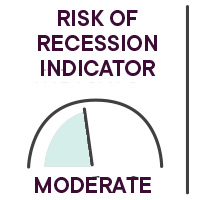Yann Furic
B.B.A., M. Sc., CFA®
Senior Portfolio Manager, Asset Allocation and Alternative Strategies
What moved the markets:
Widespread fears about inflation.
U.S. economy still growing.

|
OVERVIEW OF GLOBAL EQUITY MARKETS |
||||
|
Country |
Index |
Return |
Change |
Year-to-date |
|
Canada |
S&P/TSX |
-1.82% |
|
+4.68% |
|
United States |
S&P 500 |
-2.62% |
|
+10.48% |
|
|
Nasdaq |
-2.93% |
|
+8.90% |
|
International Stock Markets |
EAFE |
-1.08% |
|
+7.39% |
|
Emerging markets |
|
+1.98% |
|
+7.13% |
|
China |
MSCI China |
+8.22% |
|
+8.62% |
The return shown is the total return which includes the reinvestment of income and capital gains distributions.
Source: Morningstar Direct.
Results – Canadian bonds
The FTSE Canada Universe Bond Index, which includes Canadian government and corporate bonds, has posted a negative return of 3.20% year to date (at April 30, 2024). (Source: Morningstar Direct)
Our analysis of events

Still waiting for the first rate cuts
The markets continue to react to the comments of the various central banks and to revise the number and scale of anticipated rate cuts, but so far no precise date can be given as to when these cuts will made.
In the United States
- First-quarter results from U.S. companies beat expectations, keeping stock markets on track despite a postponement of rate cuts.
- The U.S. Federal Reserve (Fed) kept its key rate unchanged at its May 1 meeting. According to the latest comments from Chair Jerome Powell, cuts could come later, towards the end of 2024. We may see a first cut in November, a few days after the U.S. elections, so as not to appear to favour one candidate over another.
In Canada
- The Bank of Canada maintained its policy rate at 5% at its April 10 meeting. The rate of inflation is easing somewhat, but Governor Tiff Macklem wants firm confirmation of this trend before announcing a first cut. Markets expect a rate cut in July and another by the end of the year.
In Europe
- The European Central Bank (ECB) is expected to begin its rate cuts around mid-year, possibly in June. Markets are anticipating a total of two or three 0.25% cuts in 2024.
In brief, the rate of inflation and how quickly it falls are the two variables with the most significant impact on markets.
- For the month of March, the annual inflation rate in Canada was 2.9%, up from the previous month and in line with market expectations.
- In the United States, the annual inflation rate climbed to 5% in March, also up from 3.2% in February and above market expectations of 3.4%.
Policy rate cuts: possible scenarios in 2024
- The most positive scenario remains a rate cut due solely to a decline in inflation, with no pronounced economic slowdown.
- A strong U.S. economy, requiring fewer rate cuts, could lead to an appreciation of the U.S. dollar against other currencies. This would be negative for the Canadian dollar and would favour high inflation in Canada.
- Finally, reaccelerating inflation and a deteriorating economic situation would be the precursors of a state of stagflation, which would also be the most negative scenario.
- Although a growing number of small and medium-sized businesses are no longer profitable, the vast majority of them are still hoping for a rapid fall in interest rates, which would make it easier for them to obtain the financing they need to participate in the economic recovery.
Employment situation
In Canada, the unemployment rate was 6.1% in April, unchanged from the previous month. The number of unemployed rose by 60,000 to 1.26 million, 65% of whom had been looking for work for more than a month. On an annual basis, hourly wage growth accelerated to 5%, in line with expectations.
The latest U.S. employment data came as a surprise, with 303,000 jobs added versus forecasts of 214,000. The jobless rate therefore fell from 3.9% to 3.8%. Wage growth remained too high at 4.1%, but was down from the previous month.
Economic indicators
Global Purchasing Managers’ Index ![]()
Manufacturing segment indicators continue to hold steady, with almost half of the 30 countries in the index posting a reading above 50, which signals an expansion. Growth continues in the services segment, with a clear improvement in Europe, where Germany exceeded the 50 mark (growth).
Inflation rate ![]()
Overall, inflation is still too high to anticipate significant rate cuts. The latest data from the United States still show a robust economy and are therefore pointing in the wrong direction.
Benchmark rates in Canada, Europe and the United States ![]()
If it persists, the level of interest rates will have a major impact on household and business spending when loans are renewed. The latest U.S. inflation numbers are still too high, which will complicate the Fed’s task. This situation will further slow household consumption, as well as investment, particularly in Canada, where a large number of five-year mortgages are up for renewal within the next 24 months.

Our strategic monitoring
We are monitoring inflation as well as the leading indicators for manufacturing production, the services sector and employment. A deterioration in these numbers would prompt us to be even more cautious.
A notable improvement in the manufacturing indices and a return to an inflation rate of 2% would be strong signs of an economic recovery, but above all of a possible soft landing for the economy.
Caution and risk management remain our priorities.
Our tactical approach
In March, we increased the equity weighting in the tactical allocation strategy as the overall economic outlook improved.
In fixed income, we reduced our exposure to Canadian government bonds.
In the United States, we maintained our position in large cap growth stocks, which react positively to stabilizing interest rates, as well as in stocks with a track record of dividend growth which are more defensive.
We increased our position in small cap stocks, which react well to rate cuts, as well as in emerging economies, which respond positively to improved global economic conditions.
We maintained our overweight position in Japan relative to Europe, as the Japanese economic outlook seems brighter to us.
We continue to favour stocks in developed countries and focus on risk management.
To learn how our funds performed:
Main risks
- An overly restrictive monetary policy could cause a major recession or other problems, like the U.S. regional bank crisis.
- High interest rates for an extended period would reduce corporate profits and sharply curtail household spending.
- The possibility of an episode of stagflation, i.e. anemic economic growth and high inflation, persists. This situation is negative for stock markets.
- The Israeli-Palestinian conflict could have repercussions throughout the Middle East.
- An escalation of the conflict in Ukraine could spread to other European countries.
- There is also a risk that tensions between China and the United States over Taiwan could worsen.
Senior Manager, Asset Allocation and Alternative Strategies
Data source : Bloomberg
The opinions expressed here and on the next page do not necessarily represent the views of Professionals’ Financial. The information contained herein has been obtained from sources deemed reliable, but we do not guarantee the accuracy of this information, and it may be incomplete. The opinions expressed are based upon our analysis and interpretation of this information and are not to be construed as a recommendation. Please consult your Wealth Management Advisor.









